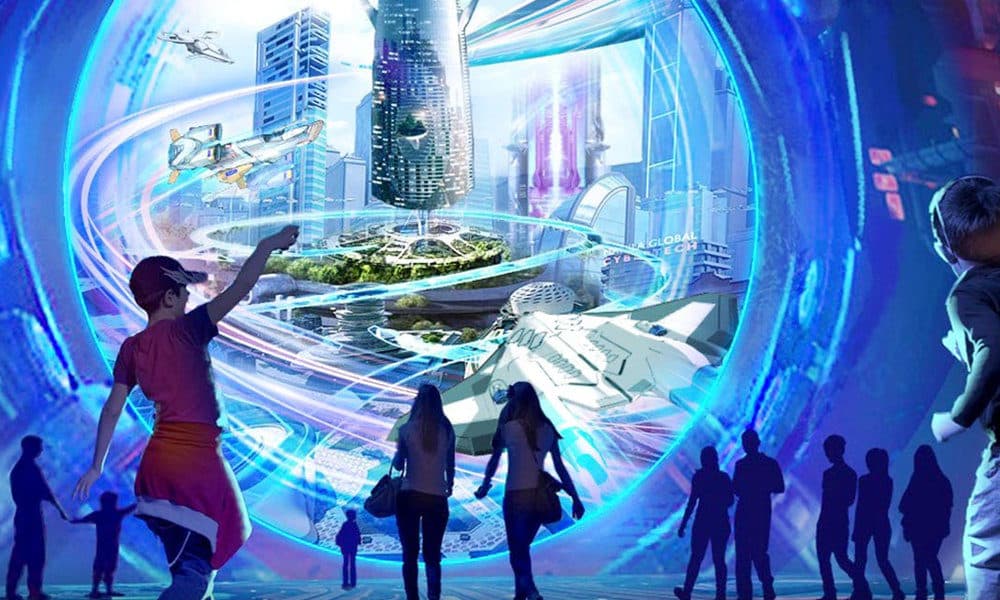About Metaverse:
- It refers to a virtual or digital universe where people can interact with each other and digital objects in a shared online space.
- Origin of the term: The term “metaverse” first appeared in author Neal Stephenson’s 1992 science-fiction novel Snowcrash, which describes a future where millions of people use virtual avatars to participate in a cyberspace realm.
- The metaverse is essentially an interconnected network of virtual worlds, augmented reality, and virtual reality environments accessible through the internet.
- In this digital realm, users can create avatars, socialize with others, engage in various activities, explore virtual landscapes, and even conduct business or trade virtual goods and services.
- Elements of the metaverse include virtual reality (VR) platforms, augmented reality (AR) experiences, online games, social media, virtual commerce, and virtual art galleries, among others.
- The metaverse aims to offer a seamless and immersive experience, blurring the lines between the physical and digital worlds.
- Companies such as Meta (formerly Facebook), Microsoft, and Roblox are all investing heavily in the metaverse, and it is seen as a potential major driver of growth in the technology industry in the coming years.
What is Augmented Reality (AR)?
- It is an enhanced version of the real physical world that is achieved through the use of digital visual elements, sound, or other sensory stimuli and delivered via technology.
- It overlays digital content onto real-life environments and objects.
- AR works by superimposing digital information onto real-world objects to create a 3D experience that allows users to interact with both the physical and digital worlds.
- Unlike Virtual Reality (VR), which creates its own cyber environment, AR adds to the existing world as it is.
What is Virtual Reality (VR)?
- It is a simulated 3D environment that enables users to explore and interact with virtual surroundings in a way that approximates reality as it is perceived through the users’ senses.
- The environment is created with computer hardware and software, and the users need to wear devices such as helmets or goggles (Virtual Reality headsets for helmets) to interact with the environment.
Q1) What is generative artificial intelligence (AI)?
Generative AI is a type of artificial intelligence (AI) that can create new content, such as text, images, or music. Generative AI models learn the patterns and structure of their input training data by applying neural network machine learning techniques, and then generate new data that has similar characteristics.
Source: Metaverse users to surpass over 600 million by 2026 due to generative AI: Report
Last updated on June, 2025
→ UPSC Notification 2025 was released on 22nd January 2025.
→ UPSC Prelims Result 2025 is out now for the CSE held on 25 May 2025.
→ UPSC Prelims Question Paper 2025 and Unofficial Prelims Answer Key 2025 are available now.
→ UPSC Calendar 2026 is released on 15th May, 2025.
→ The UPSC Vacancy 2025 were released 1129, out of which 979 were for UPSC CSE and remaining 150 are for UPSC IFoS.
→ UPSC Mains 2025 will be conducted on 22nd August 2025.
→ UPSC Prelims 2026 will be conducted on 24th May, 2026 & UPSC Mains 2026 will be conducted on 21st August 2026.
→ The UPSC Selection Process is of 3 stages-Prelims, Mains and Interview.
→ UPSC Result 2024 is released with latest UPSC Marksheet 2024. Check Now!
→ UPSC Toppers List 2024 is released now. Shakti Dubey is UPSC AIR 1 2024 Topper.
→ Also check Best IAS Coaching in Delhi
























